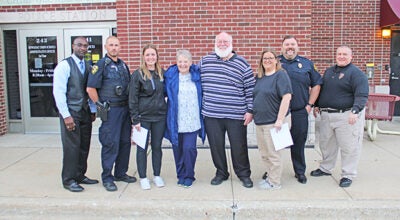Veteran Vonnegut’s birthday celebrated at Union High
Published 9:18 am Thursday, November 12, 2009

Megan Corey slices a pumpkin pie Wednesday at Kurt Vonnegut’s 87th birthday party. The first Dogwood Fine Arts Festival visiting author was born on Veterans Day in 1922 and was a Nazi prisoner of war who survived the firebombing of Dresden. In a trivia contest with Jeopardy categories about the author and Sixties culture, the girls team racked up 2,040 points to defeat the guys. (The Daily News/John Eby)
By JOHN EBY
Dowagiac Daily News
Kurt Vonnegut Jr., the first Dogwood Fine Arts Festival visiting author in 1993, was born in Indianapolis on Nov. 11, 1922.
The World War II prisoner of war would have turned 87 Wednesday on Veterans Day. He died April 11, 2007, at 84.
Union High School English teacher Rich Frantz celebrated the former reporter’s birthday with his students, who read “Slaughterhouse-Five” as part of his class.
Frantz’s classroom is running out of wall space to be decorated with more students’ portraits of literary legends who have visited Dowagiac.
The pointed party hat affixed to the curly hair of Vonnegut’s flat likeness juts out, making him look like a unicorn.
A double-decker chocolate cake is frosted with his unique autograph he explains in “Breakfast of Champions” and his squiggly self-portrait done on his 82nd birthday in 2004 which adorns the cover of “A Man Without a Country.”
The wall nearest the hall contains different sorts of images – Dresden before and after the firebombing Vonnegut survived to write “Slaughterhouse-Five” about in 1968.
In Dresden, on Feb. 13, 1945, about 135,000 people were killed by British firebombing in one night.
“It was pure nonsense, pointless destruction,” he wrote. “The whole city was burned down, and it was a British atrocity – not ours.”
Vonnegut felt liberated by the unpopularity of Vietnam to finally report “what we did to the worst people imaginable, the Nazis. And what I saw … made war look so ugly. You know, the truth can be really powerful stuff. You’re not expecting it.”
Of course, there’s much more to Vonnegut’s best-known novel than recounting the horrors of war, like hero Billy Pilgrim becoming “unstuck in time” and visiting events from his life in random sequence, from Dresden to his peaceful life as an optometrist in Ilium, N.Y., or the fantasy of being mated to the movie star Montana Wildhack in a zoo on the planet Tralfamadore.
Pilgrim is a perpetual victim of circumstance, but Tralfamadorians can teach him to accept life as it comes because he has no power to alter it.
Vonnegut, who studied anthropology at the University of Chicago, was the son and grandson of architects.
As the youngest child in his family, nine years younger than his brother, he became a jokemaker “because a joke is the only way he can enter into an adult conversation.”
Vonnegut made observations like, “There is no reason good can’t triumph over evil, if only angels will get organized along the lines of the mafia.”
“I grew up at a time when comedy in this country was superb – it was the Great Depression,” he said.
His family also had a tradition of pacifism and atheism, which figure prominently in his novels.
As a humanist, “We try to behave as decently, as fairly, and as honorably as we can without any expectation of rewards or punishments in an afterlife.”
He hoped his epitaph would be, “The only proof he needed for the existence of God was music.”
His first writing happened to be reporting because his alma mater, Shortridge, had the first high school daily newspaper in the country, the Daily Echo.
In 1940, Vonnegut entered Cornell University as a biochemistry major. He also wrote for the student newspaper there.
Despite his pacifism and German-American heritage, Vonnegut volunteered for military service in 1943.
The Army sent him to Carnegie Tech to study engineering. He transferred to the infantry and served as a scout during the Allied invasion of Europe.
Captured by the Nazis, Vonnegut was imprisoned in Dresden when the Allies bombed the city – an incident mentioned in several of his books and the major setting for Slaughterhouse-Five.
Some label Vonnegut a science fiction writer, which he blamed on writing about corporate life in Schenectady, N.Y., in his first novel, “Player Piano,” in 1952.
“There are huge factories and nothing else,” he wrote. “I and my associates were engineers, physicians, chemists and mathematicians … when I wrote about the General Electric Co. and Schenectady, it seemed a fantasy of the future to critics who had never seen the place.
“I think that novels that leave out technology misrepresent life as badly as Victorians misrepresent life by leaving out sex.”
On drugs, Vonnegut said he was a “coward” when it came to cocaine, LSD or heroin, “afraid they might put me over the edge.”
He claimed to have smoked just one joint of marijuana with Jerry Garcia and the Grateful Dead. He never consumed more than two drinks.
But he was “notoriously hooked on cigarettes. I keep hoping the things will kill me. A fire at one end and a fool at the other.”
He said a bigger high than crack cocaine was when he first got his driver’s license and could tool around in his Studebaker, powered by “the most abused, addictive and destructive drugs of all: fossil fuels.”
Vonnegut once owned and managed an automobile dealership in West Barnstable, Mass., called Saab Cape Cod, where he sold the Swedish cars.
Though Pulitzer Prize-winning poet Gwendolyn Brooks “opened up the door,” Vonnegut was the justification for a week-long Dogwood Fine Arts Festival.
“He made it kind of cool to come here,” Frantz said, plus he influenced John Updike to come the second year after Joyce Carol Oates was already booked – making 1994 still the only year with two authors in one May week.
Frantz’s favorite is “Cat’s Cradle,” the surrealistic 1963 fantasy about the end of the world set on the Caribbean island of San Lorenzo, where a bizarre new religion, Bokononism, has sprung up.
Vonnegut succeeds at satirizing both religion and science as ways of codifying man’s knowledge.
One of his students says she looks forward to next reading 1965’s “God Bless You, Mr. Rosewater,” about the attempts an eccentric millionaire to do his part in establishing Utopia.






